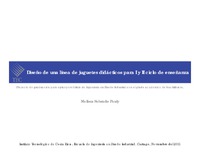Mostrar el registro sencillo del ítem
Diseño de una línea de juguetes didácticos para I y II ciclo de enseñanza
| dc.contributor.author | Sobrado-Pauly, Melissa | |
| dc.date.accessioned | 2017-04-28T21:56:32Z | |
| dc.date.available | 2017-04-28T21:56:32Z | |
| dc.date.issued | 2011 | |
| dc.identifier.uri | https://hdl.handle.net/2238/7034 | |
| dc.description | Proyecto de Graduación (Bachillerato en Ingeniería en Diseño Industrial) Instituto Tecnológico de Costa Rica, Escuela de Diseño Industrial, 2011. | es |
| dc.description.abstract | The following project has as it´s main goal to design a series of didactic toys for the classroom which optimize the learning of children in the different levels of I and II Cycle of the Costarican teaching system. The project came up after detecting an actual shortage of these type of toys for teaching traditional subjects in schools nationwide. The first step is setting the project´s goals to then define it´s reach. Afterwards, the research phase begins where the main teaching principles and characteristics are studied as well as the national study programs to decide on the specific theme in which the project´s development will be focused. Other aspects such as target market, potential demand, user´s profile, state of the art and possible materials and transformation processes are analyzed as well, among others, to make important decisions project wise. The solution consists in a didactic toy series, concerning the specifi c subject of geometry and fractions, for kids from fi rst to sixth grade, divided in three modules which evolve along with the kids´ abilities and learning necessities. It´s an environmentally friendly and locally manufactured proposal which pretends to complement the theoretical lessons taught in the schools, looking to optimize the childrens´ learning. The idea behind it is that the use of manipulatives for teaching stimulates many skills and offers a much higher level of withholding information. The understanding of the basic principles of any subject is the key behind a long lasting and solid education. | es |
| dc.description.abstract | El siguiente proyecto tiene como objetivo general diseñar una línea de juguetes didácticos para el aula que optimice el aprendizaje de los niños para los distintos niveles de I y II Ciclo de Enseñanza. El proyecto surgió al detectar una carencia de dichos juguetes en escuelas a nivel nacional para la enseñanza de materias tradicionales. Se comienza por delimitar los alcances y objetivos del proyecto para dar inicio a la fase de investigación en donde se estudian las características y principios del aprendizaje, así como los programas de estudio nacionales para delimitar el tema específico sobre el cual se desarrollará el proyecto. Además, se analizan aspectos como el mercado meta, la demanda potencial, el perfil del usuario, el estado del arte y los materiales y procesos posibles, entre otros, para tomar decisiones en cuanto al desarrollo de la propuesta. La solución consiste en una línea de juguetes enfocado a geometría y fracciones para niños de primero a sexto grado, compuesta por tres módulos que evolucionan con el niño acorde a sus destrezas y necesidades de aprendizaje. Es una propuesta amigable con el ambiente y producción nacional que pretende complementar el aprendizaje teórico impartido en escuelas con el fi n de optimizar el aprendizaje de los niños. Se parte de la idea de que la utilización de manipulables en la enseñanza estimula muchas habilidades y permite retener una mayor cantidad de información a largo plazo. La comprensión de los principios básicos de cualquier materia es la clave para una educación sólida | |
| dc.language.iso | spa | es |
| dc.publisher | Instituto Tecnológico de Costa Rica | es |
| dc.rights | acceso abierto | es |
| dc.subject | Juguetes | es |
| dc.subject | Enseñanza | es |
| dc.subject | Educación | es |
| dc.subject | Geometría | es |
| dc.subject | Matemáticas | es |
| dc.subject | Research Subject Categories::SOCIAL SCIENCES::Social sciences::Education::Subject didactics | es |
| dc.title | Diseño de una línea de juguetes didácticos para I y II ciclo de enseñanza | es |
| dc.type | proyecto fin de carrera | es |


